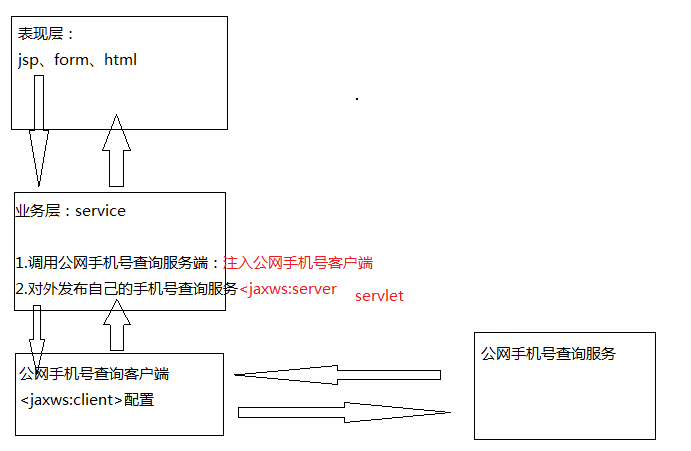Web Service——CXF发布REST服务
1. 什么是REST
REST,英文representational state transfer(表象性状态转变)或者表述性状态转移,REST是web服务的一种架构风格,使用HTTP、URI、XML、JSON、HTML等广泛流行的标准和协议,轻量级、跨平台、跨语言的架构设计,它是一种设计风格,是一种思想,而不是一种标准。只是提供了一组设计原则和约束条件。它主要用于客户端和服务器交互类的软件。基于这个风格设计的软件可以更简洁,更有层次,更易于实现缓存等机制。
Rest要求对资源定位更加准确,如下:
- 非REST方式:http://ip:port/queryUser.action?userType=student&id=001
- REST方式:http://ip:port/user/student/query/001
REST架构的主要原则
- 网络上的所有事物都被抽象为资源
- 每个资源都有一个唯一的资源标识符
- 同一个资源具有多种表现形式(xml,json等)
- 对资源的各种操作不会改变资源标识符
- 所有的操作都是无状态的
- 符合REST原则的架构方式即可称为RESTful
2. 发布REST服务
注意:REST 不等于WebService,JAX-RS 只是将REST 设计风格应用到Web 服务开发上。
2.1 需求
发布查询学生信息的服务,以json和xml数据格式返回。
2.2 服务端
第一步:导入jar包
第二步:创建学生pojo类,要加入@ XmlRootElement
import java.util.Date;
import javax.xml.bind.annotation.XmlRootElement; @XmlRootElement(name = "student") // @XmlRootElement可以实现对象和XML数据之间的转换
public class Student { private long id;
private String name;
private Date birthday;
···
}
第三步:创建SEI接口(主要步骤,注意注解使用)
import java.util.List;
import javax.jws.WebService;
import javax.ws.rs.GET;import javax.ws.rs.Path;
import javax.ws.rs.PathParam;
import javax.ws.rs.Produces;
import javax.ws.rs.core.MediaType;
import com.zang.ws.rest.pojo.Student; @WebService
@Path("/student") // @Path("/student")就是将请求路径中的“/student”映射到接口上
public interface StudentInterface { // 查询单个学生
@GET // 指定请求方式,如果服务端发布的时候指定的是GET(POST),那么客户端访问时必须使用GET(POST)
@Produces(MediaType.APPLICATION_XML) // 指定服务数据类型
@Path("/query/{id}") // @Path("/query/{id}")就是将“/query”映射到方法上,“{id}”映射到参数上,多个参数,以“/”隔开,放到“{}”中
public Student query(@PathParam("id") long id); // 查询多个学生
@GET // 指定请求方式,如果服务端发布的时候指定的是GET(POST),那么客户端访问时必须使用GET(POST)
@Produces({ "application/json;charset=utf-8", MediaType.APPLICATION_XML }) // 指定服务数据类型
@Path("/queryList/{name}") // @Path("/queryList/{name}")就是将“/queryList”映射到方法上,“{name}”映射到参数上,多个参数,以“/”隔开,放到“{}”中
public List<Student> queryList(@PathParam("name") String name);
}
第四步:创建SEI实现类
import java.util.ArrayList;
import java.util.Date;
import java.util.List; import com.zang.ws.rest.pojo.Student; public class StudentInterfaceImpl implements StudentInterface { @Override
public Student query(long id) {
Student st = new Student();
st.setId(101);
st.setName("小华");
st.setBirthday(new Date());
return st;
} @Override
public List<Student> queryList(String name) {
Student s1 = new Student();
s1.setId(101);
s1.setName("小华");
s1.setBirthday(new Date()); Student s2 = new Student();
s2.setId(102);
s2.setName("小黄");
s2.setBirthday(new Date()); List<Student> list = new ArrayList<Student>();
list.add(s1);
list.add(s2);
return list;
}
}
第五步:发布服务,JAXRSServerFactoryBean发布服务,3个参数,1:服务实现类;2.设置资源类;3.设置服务地址
package com.zang.ws.rest.server;
import org.apache.cxf.jaxrs.JAXRSServerFactoryBean;
public class StudentServer {
public static void main(String[] args) {
// JAXRSServerFactoryBean发布REST的服务
JAXRSServerFactoryBean jaxRSServerFactoryBean = new JAXRSServerFactoryBean();
// 设置服务实现类
jaxRSServerFactoryBean.setServiceBean(new StudentInterfaceImpl());
// 设置资源类,如果有多个资源类,可以以“,”隔开。
jaxRSServerFactoryBean.setResourceClasses(StudentInterfaceImpl.class);
// 设置服务地址
jaxRSServerFactoryBean.setAddress("http://127.0.0.1:12345/user");
// 发布服务
jaxRSServerFactoryBean.create();
}
}
第六步:访问即可
http://127.0.0.1:12345/user/student/query/101 查询单个学生,返回XML数据
http://127.0.0.1:12345/user/student/queryList/101?_type=json 查询多个学生,返回JSON
http://127.0.0.1:12345/user/student/queryList/101?_type=xml 查询多个学生,返回XML
注意:
- 如果服务端发布时指定请求方式是GET(POST),客户端必须使用GET(POST)访问服务端,否则会报异常。
- 如果在同一方法上同时指定XML和JSON媒体类型,在GET请求下,默认返回XML,在POST请求下,默认返回JSON。
2.3 客户端
客户端主要获取服务端发布的数据并解析
测试POST请求,将StudentInterface接口中的queryList方法声明为@POST
import java.io.BufferedReader;
import java.io.IOException;
import java.io.InputStream;
import java.io.InputStreamReader;
import java.net.HttpURLConnection;
import java.net.URL; public class HttpClient { public static void main(String[] args) throws IOException {
//第一步:创建服务地址,不是WSDL地址
URL url = new URL("http://127.0.0.1:12345/user/student/queryList/101");
//第二步:打开一个通向服务地址的连接
HttpURLConnection connection = (HttpURLConnection) url.openConnection();
//第三步:设置参数
//3.1发送方式设置:POST必须大写
connection.setRequestMethod("POST");
//3.2设置数据格式:content-type
//3.3设置输入输出,因为默认新创建的connection没有读写权限,
connection.setDoInput(true); //第五步:接收服务端响应,打印
int responseCode = connection.getResponseCode();
if(200 == responseCode){//表示服务端响应成功
InputStream is = connection.getInputStream();
InputStreamReader isr = new InputStreamReader(is);
BufferedReader br = new BufferedReader(isr); StringBuilder sb = new StringBuilder();
String temp = null;
while(null != (temp = br.readLine())){
sb.append(temp);
}
System.out.println(sb.toString());
is.close();
isr.close();
br.close();
}
}
}
3. CXF+Spring整合发布REST的服务
3.1 服务端
第一步:创建web项目(引入jar包)
第二步:创建POJO类
第三步:创建SEI接口
第四步:创建SEI实现类
第五步:配置Spring配置文件,applicationContext.xml,<jaxrs:server>,设置1.服务地址;2.服务实现类
<?xml version="1.0" encoding="UTF-8"?>
<beans xmlns="http://www.springframework.org/schema/beans"
xmlns:xsi="http://www.w3.org/2001/XMLSchema-instance" xmlns:jaxws="http://cxf.apache.org/jaxws"
xmlns:jaxrs="http://cxf.apache.org/jaxrs" xmlns:cxf="http://cxf.apache.org/core"
xsi:schemaLocation="http://www.springframework.org/schema/beans
http://www.springframework.org/schema/beans/spring-beans.xsd
http://cxf.apache.org/jaxrs http://cxf.apache.org/schemas/jaxrs.xsd
http://cxf.apache.org/jaxws http://cxf.apache.org/schemas/jaxws.xsd
http://cxf.apache.org/core http://cxf.apache.org/schemas/core.xsd">
<!-- <jaxrs:server发布REST的服务 ,对JAXRSServerFactoryBean类封装-->
<jaxrs:server address="/user">
<jaxrs:serviceBeans>
<ref bean="studentInterface"/>
</jaxrs:serviceBeans>
</jaxrs:server> <!-- 配置服务实现类 -->
<bean name="studentInterface" class="cn.zang.ws.rest.server.StudentInterfaceImpl"/>
</beans>
第六步:配置web.xml
<?xml version="1.0" encoding="UTF-8"?>
<web-app xmlns:xsi="http://www.w3.org/2001/XMLSchema-instance" xmlns="http://java.sun.com/xml/ns/javaee" xsi:schemaLocation="http://java.sun.com/xml/ns/javaee http://java.sun.com/xml/ns/javaee/web-app_3_0.xsd" id="WebApp_ID" version="3.0">
<display-name>ws_cxf_spring_rest_server</display-name> <!-- 设置spring的环境 -->
<context-param>
<!--contextConfigLocation是不能修改的 -->
<param-name>contextConfigLocation</param-name>
<param-value>classpath:applicationContext.xml</param-value>
</context-param>
<listener>
<listener-class>org.springframework.web.context.ContextLoaderListener</listener-class>
</listener> <!-- 配置CXF的Servlet -->
<servlet>
<servlet-name>CXF</servlet-name>
<servlet-class>org.apache.cxf.transport.servlet.CXFServlet</servlet-class>
</servlet>
<servlet-mapping>
<servlet-name>CXF</servlet-name>
<url-pattern>/ws/*</url-pattern>
</servlet-mapping>
</web-app>
第七步:发布到tomcat并访问
REST服务的使用说明书地址:
http://127.0.0.1:8089/ws_cxf_spring_rest_server/ws/user?_wadl
客户端使用ajax或其他方式都可以,这里不再重复。
4. 案例整合
4.1 需求
- 集成公网手机号归属地查询服务
- 对外发布自己的手机号归属地查询服务
- 提供查询界面

4.2 开发
第一步:创建web项目(引入jar包)
第二步:生成公网客户端代码
wsdl2java -p com.zang.mobile -d . http://ws.webxml.com.cn/WebServices/MobileCodeWS.asmx?WSDL
第三步:创建SEI接口
import javax.jws.WebService; @WebService
public interface MobileInterface {
public String queryMobile(String phoneNum);
}
第四步:创建SEI实现类
import com.zang.mobile.MobileCodeWSSoap;
public class MobileInterfaceImpl implements MobileInterface {
private MobileCodeWSSoap mobileClient;
@Override
public String queryMobile(String phoneNum) {
return mobileClient.getMobileCodeInfo(phoneNum, "");
}
public MobileCodeWSSoap getMobileClient() {
return mobileClient;
}
public void setMobileClient(MobileCodeWSSoap mobileClient) {
this.mobileClient = mobileClient;
}
}
第五步:创建queryMobile.jsp
<%@ page language="java" contentType="text/html; charset=utf-8"
pageEncoding="utf-8"%>
<!DOCTYPE html PUBLIC "-//W3C//DTD HTML 4.01 Transitional//EN" "http://www.w3.org/TR/html4/loose.dtd">
<html>
<head>
<meta http-equiv="Content-Type" content="text/html; charset=utf-8">
<title>手机号归属查询网站</title>
</head>
<body>
<form action="queryMobile.action" method="post">
手机号归属地查询:<input type="text" name="phoneNum"/> <input type="submit" value="查询"/><br/>
查询结果:${result}
</form>
</body>
</html>
第六步:创建MobileServlet.java
import java.io.IOException;
import javax.servlet.ServletException;
import javax.servlet.http.HttpServlet;
import javax.servlet.http.HttpServletRequest;
import javax.servlet.http.HttpServletResponse;
import org.springframework.context.ApplicationContext;
import org.springframework.web.context.support.WebApplicationContextUtils;
import com.zang.mobile.server.MobileInterface; public class MobileServlet extends HttpServlet{ private MobileInterface mobileServer; public void doGet(HttpServletRequest request, HttpServletResponse response) throws ServletException, IOException {
String phoneNum = request.getParameter("phoneNum");
if(null != phoneNum && !"".equals(phoneNum)){
ApplicationContext context = WebApplicationContextUtils.getWebApplicationContext(this.getServletContext());
mobileServer = (MobileInterface) context.getBean("mobileServer");
String result = mobileServer.queryMobile(phoneNum);
request.setAttribute("result", result);
}
request.getRequestDispatcher("/WEB-INF/jsp/queryMobile.jsp").forward(request, response);
} public void doPost(HttpServletRequest request, HttpServletResponse response) throws ServletException, IOException {
this.doGet(request, response);
}
}
第七步:配置spring配置文件,applicationContext.xml
<?xml version="1.0" encoding="UTF-8"?>
<beans xmlns="http://www.springframework.org/schema/beans"
xmlns:xsi="http://www.w3.org/2001/XMLSchema-instance" xmlns:jaxws="http://cxf.apache.org/jaxws"
xmlns:jaxrs="http://cxf.apache.org/jaxrs" xmlns:cxf="http://cxf.apache.org/core"
xsi:schemaLocation="http://www.springframework.org/schema/beans
http://www.springframework.org/schema/beans/spring-beans.xsd
http://cxf.apache.org/jaxrs http://cxf.apache.org/schemas/jaxrs.xsd
http://cxf.apache.org/jaxws http://cxf.apache.org/schemas/jaxws.xsd
http://cxf.apache.org/core http://cxf.apache.org/schemas/core.xsd">
<!-- <jaxws:server发布服务-->
<jaxws:server address="/mobile" serviceClass="com.zang.mobile.server.MobileInterface">
<jaxws:serviceBean>
<ref bean="mobileServer"/>
</jaxws:serviceBean>
</jaxws:server>
<!-- 配置服务实现类 -->
<bean name="mobileServer" class="com.zang.mobile.server.MobileInterfaceImpl">
<property name="mobileClient" ref="mobileClient"/>
</bean> <!-- 配置公网客户端 -->
<jaxws:client id="mobileClient" address="http://ws.webxml.com.cn/WebServices/MobileCodeWS.asmx"
serviceClass="com.zang.mobile.MobileCodeWSSoap"/> </beans>
第八步:配置web.xml
<?xml version="1.0" encoding="UTF-8"?>
<web-app xmlns:xsi="http://www.w3.org/2001/XMLSchema-instance" xmlns="http://xmlns.jcp.org/xml/ns/javaee" xsi:schemaLocation="http://xmlns.jcp.org/xml/ns/javaee http://xmlns.jcp.org/xml/ns/javaee/web-app_3_1.xsd" id="WebApp_ID" version="3.1">
<display-name>cxf_rest_spring_mobile</display-name> <!-- 设置spring的环境 -->
<context-param>
<!--contextConfigLocation是不能修改的 -->
<param-name>contextConfigLocation</param-name>
<param-value>classpath:applicationContext.xml</param-value>
</context-param>
<listener>
<listener-class>org.springframework.web.context.ContextLoaderListener</listener-class>
</listener> <!-- 配置CXF的Servlet -->
<servlet>
<servlet-name>CXF</servlet-name>
<servlet-class>org.apache.cxf.transport.servlet.CXFServlet</servlet-class>
</servlet>
<servlet-mapping>
<servlet-name>CXF</servlet-name>
<url-pattern>/ws/*</url-pattern>
</servlet-mapping>
<!-- 配置mobileServlet -->
<servlet>
<servlet-name>mobileServlet</servlet-name>
<servlet-class>com.zang.mobile.server.servlet.MobileServlet</servlet-class>
</servlet>
<servlet-mapping>
<servlet-name>mobileServlet</servlet-name>
<url-pattern>*.action</url-pattern>
</servlet-mapping> <welcome-file-list>
<welcome-file>index.jsp</welcome-file>
</welcome-file-list>
</web-app>
第九步:部署到tomcat下,并测试
测试服务是否发布成功

测试查询界面

Web Service——CXF发布REST服务的更多相关文章
- JAVAEE——BOS物流项目07:WebService入门、apache CXF入门、基于CXF发布CRM服务
1 学习计划 1.WebService入门 n 什么是WebService n 调用网络上的WebService服务 n SOAP和WSDL概念 n 基于JDK1.7发布一个简单的WebService ...
- CXF发布webService服务以及客户端调用
这篇随笔内容是CXF发布webService服务以及客户端调用的方法 CXF是什么? 开发工作之前需要下载CXF和安装 下载地址:http://cxf.apache.org 安装过程: <1&g ...
- 使用CXF发布WebService服务简单实例
一.说明: 前面介绍了使用axis2来发布Webservice服务,现在介绍一种更popular,更高效的Webservice服务发布技术:CXF Apache CXF = Celtix + XFir ...
- 使用CXF发布webservice服务及注意要点
一.概念 1.什么是webservice Web service是一个平台独立的,低耦合的,自包含的.基于可编程的web的应用程序,可使用开放的XML标准来描述.发布.发现.协调和配置这些应用程序,用 ...
- Web Service——CXF+Spring 整合
结合spring框架来实现CXF发布SOAP协议的服务,步骤基本相同,所不同的是的多了一些配置项,步骤如下 1. 服务端 第一步:创建web项目(引入jar包) 第二步:创建SEI接口 import ...
- Web Service——CXF
1. 什么是CXF Apache CXF = Celtix + Xfire,开始叫 Apache CeltiXfire,后来更名为 Apache CXF 了,以下简称为 CXF.Apache CXF ...
- CXF 发布rest服务
1.1 什么是rest服务 REST 是一种软件架构模式,只是一种风格,rest服务采用HTTP 做传输协议,REST 对于HTTP 的利用实现精确的资源定位. Rest要求对资源定位更加准 ...
- cxf发布 webservice服务
导包 antlr-2.7.7.jar aopalliance-1.0.jar asm-3.3.jar commons-collections-3.2.1.jar commons-lang-2.6.ja ...
- 网络开发之使用Web Service和使用WCF服务
判断是否有可用网络连接可以通过NetworkInterface类中的GetIsNetworkAvailable来实现: bool networkIsAvailable = networkInterfa ...
随机推荐
- Tomcat 下 Memcached 集群与 Terracotta 集群比较
总结:Terracotta 集群配置要比Memcached 集群简单,但Terracotta 集群启动的速度要比Memcached 集群慢,性能Terracotta 集群要比Memcached 集群好 ...
- Spring加载Hibernate 映射的几种方式及区别
LocalSessionFactoryBean有好几个属性用来查找hibernate映射文件: mappingResources.mappingLocations.mappingDirectoryLo ...
- 为 Tomcat 安装 apr
apr 官方介绍: Tomcat可以使用APR来提供超强的可伸缩性和性能,更好地集成本地服务器技术. APR(Apache Portable Runtime)是一个高可移植库,它是Apache HTT ...
- FFmpeg的H264编码有内存泄漏吗??!!!
靠,内存泄漏好严重.开始怀疑是自己代码问题,调试了半天,又反复改写和优化代码,还是泄漏严重. 拿网上现成的FFMPEG H264编码的范例来测试,同样泄漏很严重. 百度了一下,有很多人遇到同样的问题, ...
- 【BZOJ】【4066】简单题(强制在线)
KD-Tree KD-Tree的进阶姿势戳这里 http://zyfzyf.is-programmer.com/posts/92431.html 为啥有种线段树&平衡树的即视感……(树形结构的 ...
- OTL翻译(3) -- OTL的主要类
相比于传统的C++类库而言,OTL更像是一个代码容器,里面复杂,但对外的接口简单.OTL在处理程序方面受到了STL的影响. OTL有一个模板框架,它实现了otl_stream的概念.该框架由模板类和内 ...
- 任务栈 启动模式 Task Flag launchMode MD
Markdown版本笔记 我的GitHub首页 我的博客 我的微信 我的邮箱 MyAndroidBlogs baiqiantao baiqiantao bqt20094 baiqiantao@sina ...
- QlikView图表显示同比数据
数据准备例如以下: SalesData: LOAD Num(ID) as ID, Date(Date) as Date, Month, Num(Year) as Year, Num(Sales) as ...
- Maven私库安装与配置
Maven私库安装与配置 https://www.cnblogs.com/dengyulinBlog/p/6398310.html
- 6. Activity life cycle
An activity can exist in essentially three states: Resumed The activity is in the foreground of the ...
